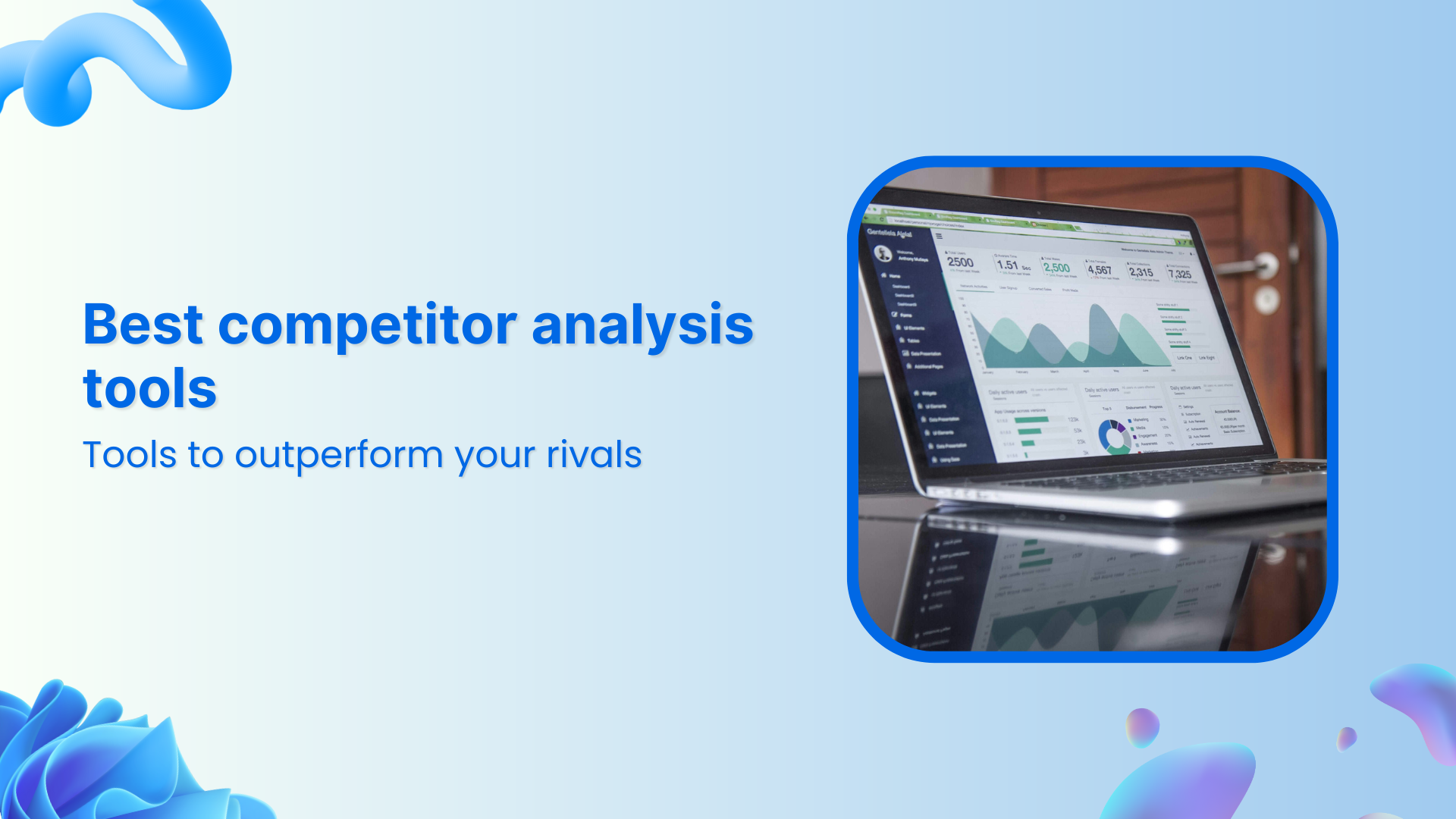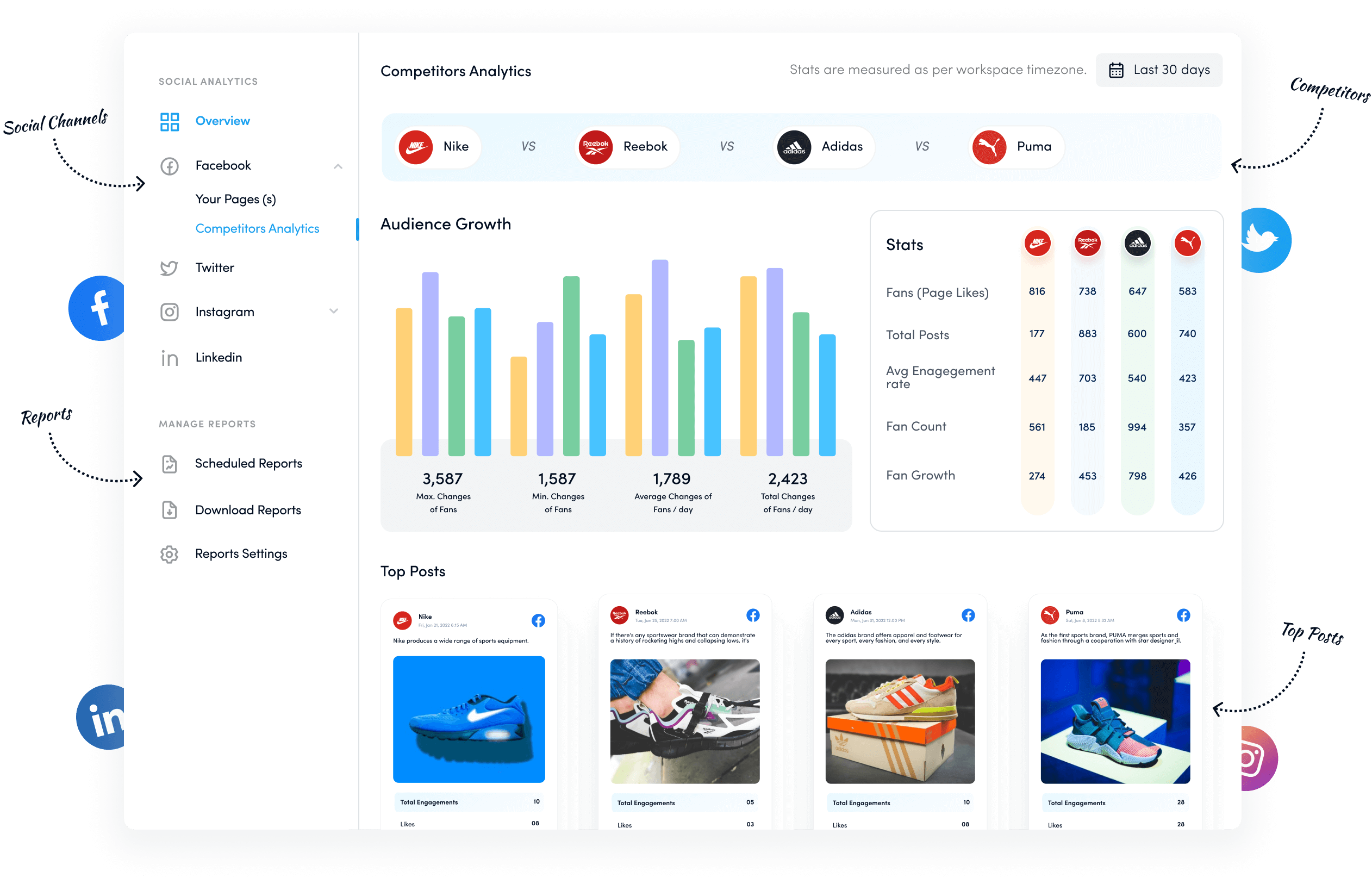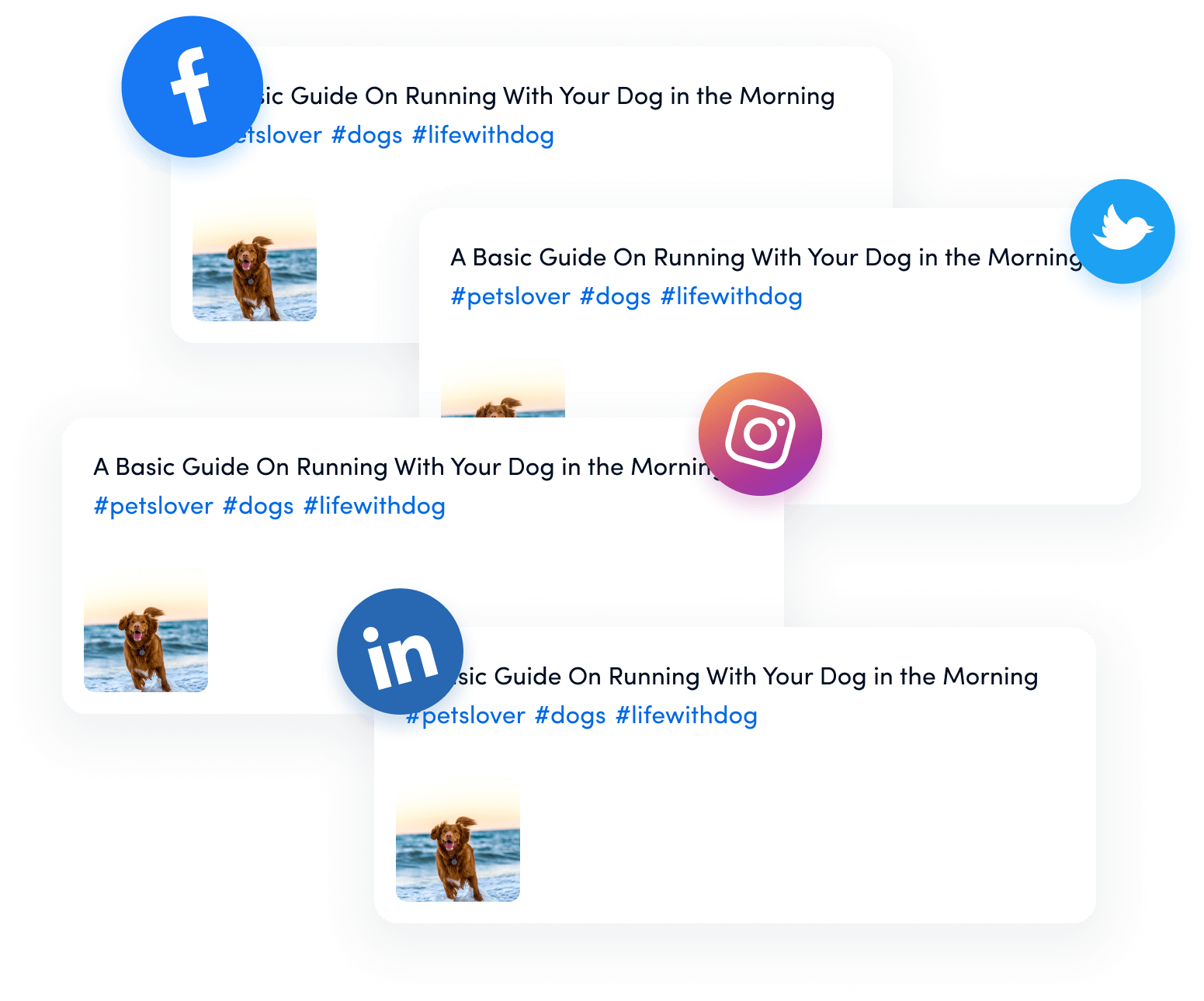Bulk-generate & schedule posts in seconds with Smart Scheduling. Try now!
15 Best competitor analysis tools to outperform your rivals

Billions of social posts, messages, and emails are delivered daily. It’s extremely difficult to cut through the noise and stand out from the crowd. Digital marketers rely heavily on competitor analysis tools to understand their competition.
Competitor analysis is required for multiple types of examinations, such as SEO performance inspection, social media analysis, PPC rate calculation, or website ranking overview.
We’ll dig deep into some of the best competition analysis tools marketers and SEO use to spy and outperform their competitors.
Social Media Analytics
Fine-tune your social media strategy for success with in-depth analytics and white-labeled reports.
Get Started for FREE
What is competitor analysis?
Competitor analysis is a process of investigating and monitoring competitors in the industry to examine, understand, and monitor their strategies. It’s a strategic plan of action to scan every marketing and engagement strategy of competitors to come up with an even better one.
However, this study of competitors isn’t based on their activities on a single platform but rather a combined analysis of their sales and marketing strategy to determine what’s working for them overall.
To do this, one must go deep into the rabbit hole and try to scratch every aspect of the competitors’ business to fully comprehend their strategy.
Competitor analysis may involve a wide range of inspections, such as:
- Website UI/UX
- Value-added services
- Product pricing
- Keywords targeting
- Social media strategies
While competitor analysis may seem a little bookish on the outside, it’s one of the essential digital marketing strategies.
In today’s social media world, SAAS companies, entrepreneurs, influencers, and marketing agencies monitor their competitors’ actions across all platforms to elicit their secret sauce and implement it in their product development and marketing strategies.
Importance of competitor analysis tools in business strategy
Brands and influencers pay attention to competitor analytics for a reason. They know that they can’t fall behind other players on the market, whether it’s the FOMO or the hazard of irrelevancy that keeps them on their toes.
Let’s try to understand the importance of competitor analysis tools in carving out a successful business growth strategy:
1. Identifying market trends and consumer behavior
Competitor analysis tools provide insights into market trends, customer preferences, and emerging industry patterns. By analyzing competitors’ content, keywords, and social media strategies, brands, agencies, and influencers can align their marketing efforts with what resonates with audiences.
Also Read: Top 12 content marketing trends you should follow in 2025
2. Comparing your strengths and weaknesses with competitors
Analyzing competitors helps businesses and entrepreneurs identify their strengths and weaknesses compared to other players in the market. The vital information allows companies to capitalize on gaps in competitors’ strategies while improving their digital marketing efforts, SEO tactics, and social media marketing.
3. Refining SEO and content marketing strategies
One of the aspects of competitor analysis is to figure out competitors’ SEO and content marketing strategies. Competitor analysis tools assist businesses in tracking which keywords are driving traffic to competitors’ websites and which content is performing well. It empowers brands and marketers to refine their own SEO and content marketing strategies, ensuring effective reach and higher conversion rates.
4. Improving social media engagement
Marketers, agencies, and influencers can discover what types of posts, hashtags, and engagement techniques work best in their industry by studying competitors’ social media strategies. It allows brands and individuals to optimize their social media presence, increase audience interaction, and enhance brand awareness without much hassle.
Related Read: Engagement hacks on social media platforms
5. Fine-tuning pricing and product offerings
Pricing is an essential element of the sales and marketing strategy. Monitoring competitors’ pricing strategies and product features can help brands adjust their offerings to remain competitive. Competitor analysis tools allow brands and influencers to recalibrate their strategy by offering promotions, understanding their unique selling points, or improving customer service.
6. Staying ahead of industry disruptions
Competitor analysis tools play an important role in helping businesses anticipate market shifts and emerging threats. By monitoring competitor innovations, strategic changes, or digital marketing shifts, influencers and brands can adapt proactively and maintain a strong competitive edge in their industry.
These are some of the important aspects of using competitor analysis tools that should not be overlooked.
Simplified social media marketing for individuals & agencies.
Try ContentStudio for FREE
What tools can be used for competitor analysis?
There are dozens of tools that assist brands and individuals in keeping track of their competitors. However, some of them are too good to be ignored. So, let’s take a look at 15 of the best competitor analysis tools for brands, marketers, and influencers:
Social media competitor analysis tools
1. ContentStudio
ContentStudio is an all-in-one social media management tool that helps marketers, brands, agencies, and influencers organize their social media publishing. It offers a complete suite for creating, managing, publishing, scheduling, and analyzing social media content across all major platforms.
Interestingly, ContentStudio also offers a competitor analysis tool to analyze competitors’ content performance on Facebook and Instagram. Moreover, several other features make social media tools a must-have in your digital marketing arsenal.
Features for competitor analysis

- Social media analytics to keep track of your social media content performance. It becomes a huge help when comparing social media content performance with competitors’ data.
- Competitor analysis tool to spy on competitors’ social media content. All users need to do is add competitors to the competitor analysis section and let the ContentStudio analyze the profile and compile data
- The performance analytics section lets users differentiate campaigns through labels or campaign names, which helps users manage and access social analytics when required
- The Manage reports feature provides data reporting. It ensures users can access the social media content performance reports through this tool
2. BrandMentions
BrandMentions is a powerful social media analytics tool that analyzes brand insights to provide effective competitor analysis and social listening services. It gathers valuable insights from competitors’ data and reports to the user for in-depth analysis.
BrandMentions is known for its high-quality web and social listening abilities that empower brands to create competitive digital marketing strategies. Moreover, this tool has several social media competitor analysis features to take your competitor analysis to the next level.
Features for competitor analysis
- Brand monitoring is an essential tool that illuminates brand mentions and tags. It reports on every brand mentioned on the web and social media platforms to gauge brand popularity and acceptance.
- Competitor spying is a feature that lets users discover competitors’ actions and ensures that they’re well aware of the competitors’ strategies as well as open to adapting to better tactics
- Business intelligence is a feature that equips brands and influencers with credible information to make informed sales and marketing decisions based on the data.
3. Meltwater
Meltwater is an advanced competitor analysis and influence tracking dashboard that helps brands, agencies, and organizations make insight-driven decisions. It uses AI-powered technology to analyze essential data and market trends and help users make important decisions efficiently and accurately.
It’s much more than just a social media management dashboard as it offers several social listening, media intelligence, and consumer research facilities that take the guesswork out of the strategy.
Features for competitor analysis
- Media intelligence is a powerful feature of Meltwater that assists users in monitoring their brands and seeing a holistic view of their brands’ existence. The purpose is to give a brand health check to compete with other brands.
- Social media listening is another useful feature of Meltwater that contributes to the competitor analysis campaign. It’s a feature that lets users see the conversations (about their companies) and brand mentions across all social media
- One of the features Meltwater offers is sales intelligence, which sharpens brands’ selling skills by analyzing competitive intelligence data, providing customized insights, and seamlessly integrating with third-party marketing tools.
- Influencer marketing is an influencer-hunting, research, and analysis tool designed for small—and large-scale businesses to find relevant influencers who match their brand values, target demographics, and product offerings.
4. SproutSocial
SproutSocial is a popular social media marketing tool that offers social media management, social listening, analytics, influencer marketing, and employee advocacy. It’s an AI-powered social media tool that flawlessly integrates with several third-party software and automation tools.
SproutSocial also tracks competitors’ performances across multiple social media platforms to create a benchmark for comparing users’ social media performance. Moreover, it has a robust data analysis and reporting system for calculating social media marketing ROI.
Features for competitive analysis
- AI-based analytics and competition analysis systems easily process a high volume of analytical data within a short span and provide actionable suggestions to skyrocket brand reputation and positioning.
- Competitor reports tracking ensures that users are fully aware of their competitors’ performances across all major social media networks and identifies content gaps in the industry.
- It utilizes AI technology to unleash several consumer insights in every aspect of competitor analysis and reassures highlighting audience preferences to make informed decisions.
Website competitor analysis tools
5. Usermaven
Usermaven is an advanced website analytics tool for monitoring website or app traffic, recording important events, and reporting engagements. It’s a handy tool for digital marketers, online businesses, e-commerce brands, bloggers, SEOs, and agencies.
Usermaven provides comprehensive website/app analytical data to analyze user behaviors, activities, and engagements. It’s also considered an alternative to Google Analytics for small businesses, bloggers, and website developers. Start your free trial!
Features for website competitor analysis
- Visual trend charts for deeply understanding the audience behaviors and bringing clarity to the audience segmentation
- The trends section reports every single source of traffic on the website, which indicates the powerful analytical and tracking system in place
- Contacts Hub highlights user behaviors from the first touch point to repeat visits—it keeps track of every action that the visitor takes on your website.
- Track user journeys with the Usermaven. This feature lets users analyze each visitor’s footprint and try to understand what sources are sending the traffic and why. It gives a comprehensive path analysis for each visitor
6. SimilarWeb
SimilarWeb is a popular website analysis tool that showcases several website statistics and digital marketing insights for websites, blogs, e-commerce stores, and other online properties.
It offers a wide range of free website analysis and premium tracking tools for monitoring, tracking, and reporting website analytical data. It also offers a competitor analysis feature for businesses that want to monitor their competitors.
Features for website competitor analysis
- Market research and benchmarketing from a digital research intelligence standpoint to understand consumer journey and audience behavior
- Deep competitor analysis through keyword research, affiliate research, and SEO & PPC ad performances to help users figure out their competitors’ strategies
- Sales intelligence to improve lead generation and lead enrichment to improve e-commerce conversion rate
- On-page website optimization to satisfy existing customers and engage new visitors to boost ecommerce sales
7. GTmetrix
GTmetrix is a powerful tool for analyzing website speed and optimization issues. It provides detailed insights into page load times, performance scores, and specific areas for improvement.
Website owners, webmasters, SEOs, and bloggers use GTmetrix to analyze their website performance and web hosting quality. The tool generates in-depth reports with waterfall charts that offer a breakdown of resource loading.
Features for website competitor analysis
- It provides a comprehensive performance score, evaluating website speed, structure, and optimization levels to benchmark against competitors
- GTmetrix saves past test results, allowing users to compare historical performance and track improvements over time, which makes it easier for users to compare current data with the previous one
- The tool allows testing from various global server locations and simulating different device types, including mobile and desktop
8. PageSpeed Insights
Google’s PageSpeed Insights is a free tool for evaluating website performance on mobile and desktop. It provides a score based on Core Web Vitals and offers actionable recommendations.
PageSpeed Insights is essential for SEO optimization and improving user experience. It integrates Lighthouse audits to assess site speed, accessibility, and best practices. It can be utilized to analyze competitors’ websites without getting noticed.
Features for website competitor analysis
- PageSpeed Insights generates separate performance scores for mobile and desktop, helping users optimize for different device experiences
- PageSpeed Insights evaluates key metrics like Largest Contentful Paint (LCP), First Input Delay (FID), and Cumulative Layout Shift (CLS).
- It shares actionable suggestions tailored to Google’s performance standards, including image optimization, caching, and script improvements
SEO and content competitor analytics tools
9. Ahrefs
Ahrefs is an all-in-one digital marketing dashboard for digital intelligence and SEO tracking. It’s one of the most popular SEO analysis tools, providing a wide range of SEO and content analysis services, such as website audits, backlink checkers, keyword research, rank tracking, and many others.
Features for SEO competitor analysis:
- Domain comparison lets you compare domains side-by-side for their backlink profiles, untapped keywords, and other missed opportunities
- The traffic checker is a vital feature of Ahrefs that lets users check their competitor’s traffic by just putting their URL
- Site audit is an essential feature of Ahrefs that goes deep into site analytical data and reports a complete SEO audit of a website
- Keywords explorer tracks every keyword a site is ranking for or could potentially rank for as it explores keywords that other tools might not be able to report
- Website authority checker is a metric that lets users check the “authority” of their root domain, which indicates the ages, reputation, and other vital scores
10. Semrush
Semrush is a remarkable SEO analysis tool for brands, digital marketers, and agencies to do keyword analysis, competitive research, PPC management, and social media marketing. It offers diverse features in SEO, content marketing, advertising, market research, and social media.
This tool is highly effective for keyword hunting, on-page SEO, local SEO, competitive analysis, rank tracking, link building, and other digital marketing aspects.
Features for SEO and content competitor analysis
- Semrush provides six advanced keyword research tools like the Keyword Magic Tool, allowing users to find high-volume, low-competition keywords, analyze search intent, and discover related keyword variations to optimize content strategy.
- Semrush offers three on-page SEO tools. They provide actionable recommendations to improve individual pages, analyzing factors like keyword usage, readability, internal linking, and technical SEO elements to boost rankings
- Local SEO has never been this important in the digital marketing landscape. Semrush helps businesses optimize their local presence by tracking local keyword rankings, managing Google Business Profile listings, and identifying citation opportunities for better visibility
- One of the essential features of Semrush is competitor analysis. It enables users to analyze competitors’ organic and paid traffic, backlink profiles, content strategies, and PPC campaigns, offering insights to refine marketing strategies and gain a competitive edge
- Semrush’s link-building tool identifies high-quality backlink opportunities, helps track backlinks, and assists in outreach efforts to improve domain authority and search engine rankings
11. Surfer
Surfer is an SEO toolkit that offers a content optimization workflow to boost SERP ranking, click-through rate, and conversion. It offers tools such as Surfer AI, Topical Map, Content Editor, and Content Audit that help improve website copy, on-page optimization, and keyword placement in the content.
Surfer is used by several SEO industry leaders and experts who work on SEO client projects and personal niche websites. It’s an excellent tool for analyzing the websites appearing on the SERPs, equipping your website to compete with competitors’ websites.
Features for SEO and content competitor analysis
- SEO audit detects problems and opportunities on the website by analyzing several areas, such as content length, page speed, meta tags, keyword density, and subheadings
- Surfer has revolutionized content auditing by automating SEO content auditing and providing essential recommendations within a few seconds. It auto-optimizes pages by inserting internal links to improve content score
- Surfer AI is a state-of-the-art on-page content optimization tool that lets users improve their blog post copy by suggesting key changes in the title, meta description, article copy, etc.
12. SEOptimer
SEOptimer is a comprehensive website analysis and SEO auditing tool that analyzes a website’s SEO performance and provides an in-depth report on its SEO characteristics.
SEO auditing involves keyword research, an SEO crawler, backlink research, keyword tracking, backlink monitoring, and other services. This tool also offers while-label SEO auditing for SEO experts and SAAS tools. SEOptimer has become a vital competitor analysis tool in the SEO and content marketing landscape.
Features for SEO competitor analysis
- Competitor tracking allows users to identify and track competitors under a single umbrella. It helps brands and marketers keep tabs on their competitors’ SEO strategies
- Keywords tracking tool dives deep into keyword search volumes, ranking positions of specific pages, and their estimated traffic to determine the competitiveness of the keywords
- It allows SEO users to generate detailed, SEO audit reports to analyze gaps in keywords, find opportunities in your content strategy, and create a better SEO roadmap
Advertising & PPC competitor analysis tools
13. Google Keyword Planner
Google Keyword Planner is one of digital marketers and advertisers’ most popular and reputed keyword analysis tools. It’s embedded in the Google Ads program (formerly known as Google Adwords).
It lets users discover potential keywords, PPC rates, and volumes, which helps advertisers determine each keyword’s potential.
Features for advertising and PPC competitor analysis
- Google Keyword Planner is designed to discover new and potential keywords for advertisers to capitalize on. It’s one of its basic functions
- Keyword research is an essential part of the SEO strategy. Google Keyword Planner lets users analyze existing and newly found keywords with details
- It also provides estimation data about the reach, clicks, cost, and other metrics to give the advertiser an idea about the potential outcome of the campaign
14. PPC Keyword Tool (by Semrush)
PPC Keyword Tool is an advertising tool from Semrush that provides insights into PPC keywords. It assists advertisers in choosing the best keywords based on cost per click, volume, and other key metrics.
Moreover, it helps build an effective keyword list, set negative keywords, and remove duplicates to improve ad campaign efficiency.
Features for advertising and PPC competitor analysis
- It sifts through the clutter and cleans up the keyword list, especially if you spied on a competitor and stole their keywords to target
- One of its features is to automatically find intersecting keywords across different ad groups in no time, which massively improves ad campaign effectiveness
- It lets advertisers easily remove keywords that are found in multiple ad groups, which enables them to narrow down their keyword list
Email competitor analysis tools
15. Owler
Owler is a business development tool that makes it easier for brands and individuals to manage follow-ups, set up email workflows, discover new prospects, and monitor competitors in the industry. It automates discovering potential clients and keeps an eye on competitors.
Features for email competitor analysis
- Finding new companies to work with hasn’t been this simple. Owler lets users discover new companies to reach out to by sending their profiles via email.
- It enables users to monitor competitors by monitoring their strategies. It offers features like competitor search and key highlights to make competitor intelligence a reality.
- This tool is good at extracting essential company information, such as CEO information, revenue, employee info, funding details, investment history, and more.
So, these are 15 of the best competitor analysis tools of different natures that entrepreneurs, marketers, and agencies would like to explore further.
How do you do a competitor analysis?
Competitor analysis is the backbone of any strategic marketing plan, regardless of industry. It undoubtedly helps businesses identify market trends, benchmark performance, and uncover opportunities to gain a competitive edge.
Here’s a step-by-step process to conduct an effective competitor analysis using the best tools available:
Step #1: Identify your competitors
First things first, recognize who your competitors are. These can be direct competitors offering the same product or service to the same audience, indirect competitors providing alternative solutions, or aspirational competitors whose strategies you want to learn from.
To identify your competitors, use every tool available, such as ContentStudio, Usermaven, Semrush, or SimilarWeb. These tools will help you uncover potential opportunities and competitors.
Step #2: Analyze their SEO and content strategy
Next, evaluate your competitors’ websites, content, and SEO strategies. Look at their organic traffic, keyword rankings, domain authority, and backlink profile. Use SEO analysis tools like Ahrefs and Semrush to gain insights into their search engine visibility.
Pay close attention to other aspects of SEO as well; for instance, study their on-page SEO factors such as site speed, structured data, and mobile-friendliness using Google PageSpeed Insights and Screaming Frog.
Step #3: Investigate their social media marketing strategy
Analyzing a competitor’s social media content efforts reveals what resonates with their audience. Go through what type of content they are putting out across all social media and marketing channels, such as social profiles, blogs, podcasts, Discord, etc.
Try BuzzSumo, which can help track their most popular content and media mentions, while tools like ContentStudio can provide insights into their social media activity as it offers a competitor analysis tool inside the Analytics section.
Read Up: Outsmart your competition with social media competitor analysis
Step #4: Evaluate their paid advertising approach
Understanding your competitors’ paid advertising strategies can guide your paid marketing campaigns. Look at their Google Ads, Facebook Ads, and other display ads campaigns to see what platforms they’re advertising on and what they’re trying to sell there. Keywords they target and how they structure their promotions.
Semrush has an advertising research tool that provides insights into its Google Ads, while the Facebook Ad Library lets you explore its social media ads.
Related Read: TikTok advertising: A complete guide to use TikTok ads in 2025
Step #5: Examine their pricing and offerings
At this step, don’t overlook competitor pricing and product offerings, as they play a crucial role in market positioning. Analyze their pricing models, feature sets, and unique selling points.
Examining their pricing strategies and product offerings would enlighten your decision-making and help steer your strategy in the right direction.
Step #6: Track customer sentiment and brand perception
Customer feedback and sentiment analysis provide valuable insights into how competitors are perceived. It won’t be a bad idea to go one step ahead and read out their customer reviews on platforms like G2, Trustpilot, or others and see what customers appreciate and what they don’t.
Utilize social listening tools like Brandwatch and Mention to help track brand mentions while reading reviews can highlight recurring customer complaints or praises.
Step #7: Set actionable goals for your brand
Once you’ve gone through all the trouble of finding, recognizing, and analyzing your competitors’ tactics, pricing, and strategies, it’d be unfair not to take something out of it.
Now is the time to create achievable goals, spot weaknesses, and clarify your strategy. Whether you’re improving SEO, refining content strategy, adjusting pricing, or enhancing paid advertising, competitor analysis equips you with the knowledge to stay ahead in your industry.
Conclusion
We shared a handful of social media and website competitor analytics tools for brands, marketers, and agencies. The purpose of sharing all these tools and strategies is to emphasize the importance of competitor analysis.
If you have neglected competitor analysis, it’s your loss because your competitors might not be making the same mistake. It means they’re already ahead in the game.
One of the reasons for sharing several types of competitor analysis tools is to ensure that most of your reading this article should get something out of it – even if you start exploring “competitor analysis” from now on, then it’s worth the effort.
FAQs about competitor analysis
Let’s take a look at some of the common questions around competitive analysis:
What is meant by competitor analysis?
Competitor analysis refers to the process of comparing two or more competitor companies side-by-side to determine which outperforms the other one with better offering, pricing, and quality.
Which tool is best for competitor analysis?
There are several competitor analysis tools for different industries, so it would be unfair to name one without a proper context. We’ve highlighted around 15 competitor analysis tools in this very article.
Is SWOT analysis a competitive analysis?
Yes, SWOT is a way of assessing your competitor’s strengths, weaknesses, opportunities, and threats. So, it can be considered a competitive analysis.
How can I analyze my competitors?
Identify who your competitors are and then pick the right tool to do a side-by-side comparison through data analysis and present it in the visual formatting to make it clear.
Recommended for you

Reputation management strategy in 2026: What every business needs to know


Powerful social media management software
14-day free trial - No credit card required.


